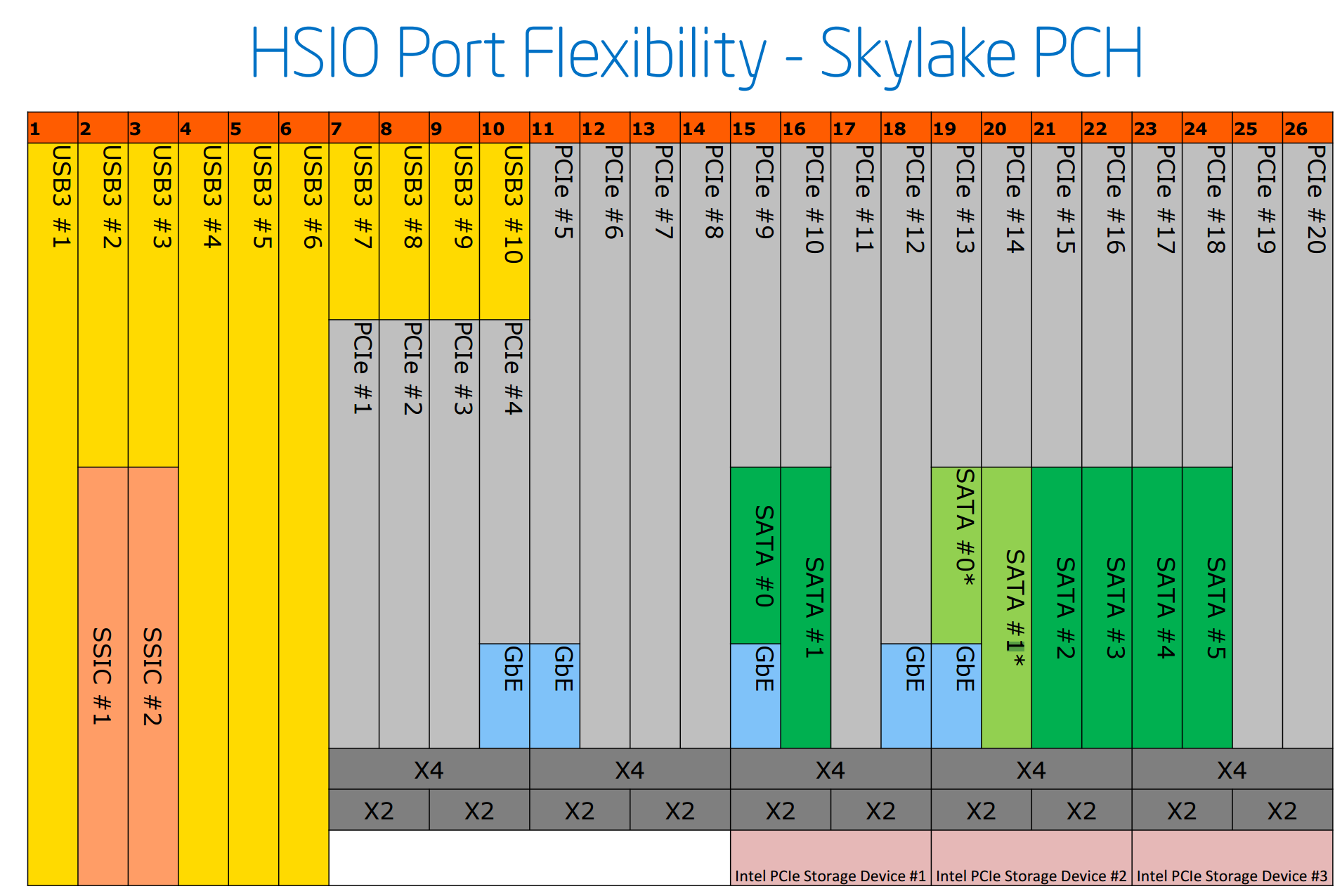A conceptual question, I suppose. If USB3 port is backwards compatible with UBS2 & 1, why do manufacturers continue to include UBS2 ports on motherboards with USB3 support? To me, there seems to be no reason to have 6 USB2 ports and 2 USB3 ports at the same time. Can't they simply include 8 USB3 ports? Or just have 4 USB3 ports if bandwidth is thought to be an issue? I just can't think of any answer.
2 Answers
It's a limitation of the motherboard chipset. For example, an Intel H81-based motherboard can support up to 2 USB 3.0 ports and 8 USB 2.0 ports.
-
Haven't considered that. Although this does bring yet another question - why design a chipset that supports both and not only many USB3?– DaniilAug 5, 2014 at 17:36
-
3@Daniil It requires more transistors, which increases the cost. It's not clear how much of this cost is artificial for marketing purposes.– JasonAug 5, 2014 at 17:46
-
Intel has a rather beautiful brochure on chips. It might help visualize what's involved.– JasonAug 5, 2014 at 18:09
-
The next question is...why is the chipset limited? If it can support USB 3 why can it only support it for a certain number of ports? :) May 30, 2018 at 17:17
-
1@rogerdpack that's a choice based on how much trade-off needed. Because resources are limited, less of them being dedicated for USB means more will be available for other high-speed connections like PCIe and Thunderbolt– phuclvJun 29, 2018 at 9:38
There are various reasons for this
For newer motherboards, there simply aren't enough die area for the complexity of USB 3.0+ standards. There are also not enough PCI-Express lanes for the USB 3.0 controller to operate at full speed for that many ports. For example the Skylake Z170 chipset has only 26 High Speed IO lanes, of which 6-10 can be dedicated for USB.
A single PCIe 3.0 lane (maximum 985 MB/s) or two PCIe 2.0 lanes (maximum 2x500 MB/s) are barely enough for 2 USB 3.1 gen 1 ports (625 MB/s per port). So you need more lanes if you want more speed/more ports, and then you'll have less lanes for the graphics cards and SATA drives. Or you can simply include a few USB 2.0 ports along the 3.0 ones, because a single PCIe 3.0 lane is enough for almost 10 USB 2.0 ports. 3 USB 3.0 ports + 10 USB 2.0 ports are vastly more useful than 4 USB 3.0 ports because very few devices actually need USB 3.0 speed. Keyboards and mice only need USB 1.0 speed and most USB sticks don't even use 1/4 the USB 2.0 speed
For older motherboards and laptops, it's because they use different controllers. The first Intel microarchitecture that has a chipset with built-in USB 3.0 support is Ivy Bridge.
- Intel to Natively Support USB 3.0 on Ivy Bridge Chipsets
- Intel delivers USB 3.0 in its chips, finally
- Correction: Ivy Bridge and Thunderbolt - Featured, not Integrated
So in earlier mainboards the manufacturers must use a separate USB 3.0 controller if they want to provide USB 3.0 functionality.
If you notice you'll see old laptops often equipped with only 1 USB 3.0 port and 1-3 USB 2.0 ports. It's because most of the external controllers only support 2 ports, and one may be used internally for some purposes. Hence only one is exposed to users and the remaining ports are connected to the native USB 2.0 controller inside the chipset. Newer laptops will have more or all USB 3.0 ports.
This happens even with new motherboards. They'll need a separate controller if they want to provide more USB ports than supported, or adopt a newer USB standard. For example on the mainboard with Skylake Z170 chipset above there are 2 solutions mentioned in the article
- Use the ASMedia ASM1142 controller with 2 PCIe lanes to provide USB 3.1 Gen 2 ports
- Use Intel’s Alpine Ridge Thunderbolt controller to provide USB 3.1 Gen 2, Thunderbolt 3 and DisplayPort with 4 PCIe lanes + DisplayPort lanes
This is also the same reason many mainboards have different SATA port types with different colors. When SATA3 was introduced, no Intel chipset supported it so mainboard manufacturers used a separate chip, often from Renesas, for controlling SATA3. The resulting mainboard will have 2 SATA3 and 2 or 4 SATA2 ports.
Some mainboards also use a 3rd party RAID SATA controller as the chipset they use don't support RAID. Those mainboards also have 4-8 SATA ports of the same type but if you want to use RAID, you must plug the cables into the correct ports that are connected to the RAID controller. Mainboards designed for people who need lots of SATA ports, to plug tens of hard disks or use RAID5 with 10 disks for example, also need separate controllers.
-
if there's anything wrong with this answer, kindly leave a comment instead of simply downvote it like that– phuclvJun 29, 2018 at 9:32
-
1I wrote the earlier simple answer and I upvoted you. :) The point about external controllers is quite apt. If memory serves, the same thing happened between USB 1 and 2. It took a while, but eventually all ports were USB 2. I suspect the same will happen with USB 3 soon.– JasonJul 3, 2018 at 15:14
-
1@Jason it already happened for USB 3.0 because all Intel chipsets since the last few years support USB 3.0. However the same thing is happening for USB 3.1 Gen 1 and 3.1 Gen 2 when you see only 1 USB-C or Thunderbolt port– phuclvJul 3, 2018 at 15:27

